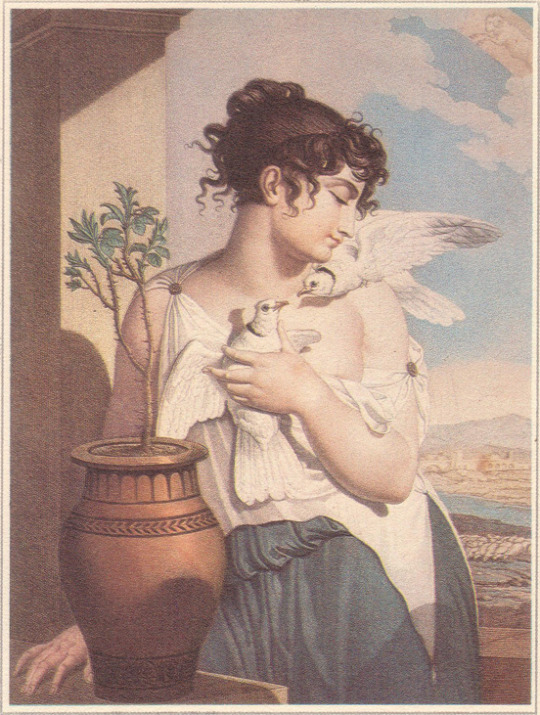#french revolutionary calendar
Text
Forget astrology — which plant, animal or gardening tool is assigned to the day on which you were born?
#frev#french revolution#frev community#frev shitposting#history#history memes#18th century#1700s#French revolutionary calendar#astrology
97 notes
·
View notes
Text
December 25th is Nivôse 5 Dog Day on the French Republican Calendar and I think that is important to mention.

#french revolutionary calendar#french republican calendar#Cat Day is in January#frev#french revolution#maximilien robespierre#any errors on Brount is because google gave me conflicting ideas
402 notes
·
View notes
Text

Floréal
Third in my series inspired by the months of the French Republican Calendar. Floréal is the second spring month, running from about the 20th of April to 19th of May. Since Floréal is named for the flowers of springtime, I went into this thinking I would recreate one of the glorious red poppy fields I saw in France as a teenager. But that was high summer. So I created picture that is truer to the springtime based on flowers one finds in the Loire Valley, namely bluebells blooming en masse before the oaks leafs out. The artistic style that inspired me was Raphael Kirchner's work for Puck Magazine--namely "Spring," from 1916.
#floreal#french revolution#French Republican Calendar#french revolutionary calendar#spring#bluebells#art nouveau#France
7 notes
·
View notes
Text

Pluviôse by Martha Romme, 1917
9 notes
·
View notes
Text
Tin
The chemical symbol for tin is Sn. This is short for the Latin name for it, stannum.
10 things you might nto know about Tin:
0 notes
Text
Happy Octidi 28 du Prairial to all my French Revolutionaries and assorted Robespierre loving madames et monsieurs! Wait shit no fuck NO DONT SEND ME TO THE GUILLOTINE I DIDNT MEAN TO SAY MADAMES ET MONSIEUR PLEASE IM NOT AN ENEMY OF THE REVOLUTION NOOOOOOOO
0 notes
Text
Revolutionaries' Birthdays on the Republican Rural Calendar
Note: The Revolutionary Rural Calendar was designed in 1793 by Fabre d'Eglantine to replace the Catholic Saints calendar, and ultimately help secularize France. This just includes some of the most prominent revolutionaries' birthdays in the rural calendar format :) I think all the symbols are fascinating. My birthday symbol is a grape on the calendar!
Maximilien Robespierre:
6 May = 17 Floréal = Pimprenelle (Salad burnet)

Louis-Antoine de Saint-Just:
25 August = 8 Fructidor = Apocyn (Apocynum)

Jean-Paul Marat:
May 24 = 5 Prairial = Canard (Duck)

Camille Desmoulins:
2 March = 12 Ventôse = Orme (Elm)

Georges Danton:
26 October = 5 Brumaire = Oie (Goose)

#french revolution#french rev#frev#history#jean paul marat#marat#resources#saint just#camille desmoulins#maximilen robespierre#robespierre#danton#revolutionary calendar
115 notes
·
View notes
Note
As a history professor, what stance do you take in the classroom on the B.C. / B.C.E. and A.D. / C.E. issue?
BCE and CE is creating a solution to a problem that does not exist, though for consistency we might also rename the days of the week and the names of the months to remove their offensive references to religion
636 notes
·
View notes
Text
Décadi 10 Germinal an CCXXXII
(Vendredi 29 mars 2024 / Friday, March 29th, 2024)
🇨🇵 Texte en français et en anglais / Text in French and English 🇬🇧/🇺🇲


Le calendrier républicain, adopté pendant la Révolution française, était une tentative de rompre avec le passé monarchique et catholique en instaurant un système de mesure du temps basé sur les valeurs républicaines et agricoles. Chaque jour du calendrier républicain était dédié à une plante, un animal, un outil ou un événement symbolique, reflétant ainsi les idéaux de la Révolution.
Le mois de Germinal dans le calendrier républicain français représente le renouveau et la vitalité de la nature au printemps. Du 20 mars au 19 avril, Germinal est le mois où la terre se réveille de son sommeil hivernal, où les bourgeons éclosent et où les premières fleurs colorent les paysages. Il incarne le début de la saison des semailles et le travail de la terre, symbolisant ainsi l'espoir et la promesse d'une nouvelle récolte. Germinal rappelle également les idéaux républicains de liberté, d'égalité et de fraternité, en invitant chacun à contribuer à l'essor de la société et à cultiver un avenir meilleur.
La journée du 10 Germinal dans le calendrier républicain français était dédiée au "couvoir", un meuble ancien utilisé pour l'incubation des œufs. Cette journée était une occasion pour les républicains français de célébrer et de reconnaître l'importance de l'agriculture et de l'élevage dans la société.
Le couvoir était un élément essentiel de l'économie agricole, permettant aux agriculteurs d'augmenter leur production en élevant des poussins à partir d'œufs fécondés. C'était un processus méticuleux qui exigeait une surveillance constante de la température et de l'humidité pour assurer le bon développement des embryons.
Cette journée était l'occasion de sensibiliser à l'importance de protéger la biodiversité et de préserver les races de volailles locales.
Pour les écoliers et les étudiants, la journée du 10 Germinal était l'occasion d'apprendre sur l'histoire de l'agriculture et de l'élevage en France, ainsi que sur l'évolution des techniques et des outils utilisés dans ces domaines. C'était également une opportunité d'encourager les jeunes à s'impliquer dans l'agriculture et l'élevage, en tant que moyen de préserver notre patrimoine culturel et de contribuer à la sécurité alimentaire.
En résumé, la journée du 10 Germinal était une occasion de célébrer et de valoriser l'importance de l'agriculture et de l'élevage, ainsi que de sensibiliser à la préservation des traditions agricoles et artisanales françaises.
***
The Republican calendar, adopted during the French Revolution, was an attempt to break away from the monarchic and Catholic past by establishing a system of time measurement based on republican and agricultural values. Each day of the Republican calendar was dedicated to a plant, an animal, a tool, or a symbolic event, thus reflecting the ideals of the Revolution.
The month of Germinal in the French Republican calendar represents the renewal and vitality of nature in spring. From March 20 to April 19, Germinal is the month when the earth awakens from its winter slumber, when buds burst open, and the first flowers color the landscapes. It embodies the beginning of the sowing season and the work of the land, symbolizing hope and the promise of a new harvest. Germinal also recalls the republican ideals of liberty, equality, and fraternity, inviting everyone to contribute to the advancement of society and cultivate a better future.
The 10th of Germinal in the French Republican calendar was dedicated to the "couvoir," an ancient piece of furniture used for egg incubation. This day was an opportunity for the French republicans to celebrate and recognize the importance of agriculture and livestock in society.
The "couvoir" was an essential element of agricultural economy, allowing farmers to increase their production by raising chicks from fertilized eggs. It was a meticulous process that required constant monitoring of temperature and humidity to ensure the proper development of embryos.
This day provided an opportunity to raise awareness about the importance of protecting biodiversity and preserving local poultry breeds.
For schoolchildren and students, the 10th of Germinal was a chance to learn about the history of agriculture and livestock farming in France, as well as the evolution of techniques and tools used in these fields. It was also an opportunity to encourage young people to get involved in agriculture and livestock farming as a means of preserving our cultural heritage and contributing to food security.
In summary, the 10th of Germinal was an occasion to celebrate and value the importance of agriculture and livestock farming, as well as to raise awareness about preserving French agricultural and artisanal traditions.
#calendrier#calendrier républicain#calendrier républicain français#calendrier révolutionnaire#calendrier révolutionnaire français#france#français#révolution#french revolution#Germinal#couvoir#oeufs#agriculture#nature#révolution française#french#french calendar#francais#revolutionary
8 notes
·
View notes
Text

Tag with what month you were born in according to the French revolutionary calendar!
220 notes
·
View notes
Note
Hey! I'm a big fan of your historical work (especially your sewing!) and thumbed through your pinterest awhile ago (thank you for linking it at some point) and was wondering if you have any reference books for period fashion that you like! Not any period in specifics, just any literature or media that you've found helpful, or return to often! Thank yeww
Hello ! I've listed a few books that were useful to me to understand construction on historical clothing in this post, but I've used those books more in my little historical costuming hobbies than for design.
When it come to character design historical references, my main sources are portraiture and contemporary illustration and I find most of it on archives or museum's online ressources. The only physical book of that type I sometimes use is Racinet's Costume History. I have a few books for napoleonic uniforms that sometimes come in handy including a few from the Men-at-Arms series of Osprey.
I think my main hubs for design references are probably the online collection of the V&A and Gallica BNF (the online ressource of the french national library).
For medieval stuff, I like to look at digitized versions of heavily illuminated manuscript like Les Très Riches Heures du Duc de Berry in the collection of the castle of Chantilly ( loads of colourful XVth century fashion) or the lovely Manesse Codex on the website of the Heidelberg University Library (14th century, some of these are the cutest stuff you've ever seen).
These days, for my revolutionary calendar project, I'm using a lot of illustrations from the Gallica digitizations of several "Cris de Paris " street studies, esp the ones by Vernet and Poisson, for reference of commonfolk clothing from the late 18th century and early 19th.
For 16th-17th century stuff, it's even earsier ; paintings from the early modern era depict garments very realistically both in upperclass portraiture and in scenes that represent lower class people like tavern scenes and the like. For these I honestly just rely on wikisource for high res files of classic european masters stuff.
To be fair I usually hang out on Pinterest, try to find stuff that looks credible and matches the vibe of whichever project I'm working on and work backwards looking for the sources if I don't know them already. A lot of old fashion plate books and manuscript can be found fully digitized online, no need for an expensive library and acres of shelf space ! Hope this helps !
548 notes
·
View notes
Text
如月 (kisaragi) “February” (archaic)

Like many countries, Japan uses a 12-month calendar. The names are very simple. January is literally "Month one" 一月, February is "Month two" 二月, etc.
However, before the Meiji Restoration (mid-1800s) it was common to use an older 12-month system. These months’ names referenced the weather and the seasons (similar to the French Revolutionary calendar).
"February" is 如月. Japanese learners will recognise the kanji 月 as "moon" or "month".
The first kanji is not common these days. It can be substituted with 衣更, which has the same sound and gives clues as to the original meaning of the month. 衣 means clothing and 更 refers to a continuing demand for something. So February is the month when it is still cold so you still need all your warm winter clothes.
This old calendar system is based on a lunar calendar with exactly 28 days in each month, beginning and ending on the new moon. An obvious disadvantage to this system is that the months don’t fit into a year exactly, and so the months will get earlier and earlier each year Every so often the calendar had to be adjusted a little.
#japanese language#japanese culture#書道#japan#japanese#japanese calligraphy#japanese art#calligraphy#kanji#japanese langblr#February
58 notes
·
View notes
Text
A List of Relatable Things Stanisława Przybyszewska has done/written:
Studied philosophy at a university for one semester until "nervous exhaustion forced her to abandon her course"
Dated her letters by the French Revolutionary Calendar
Was known to often be humming La Marseillaise
Called Camille a twink in her play (okay, to be fair she used the word 'ephebe', but I'd argue that is as close to twink as you can get in the 1920s)
Worked at a leftist bookstore (and was subsequently arrested for it)
Took a stray cat from the street which at one point "was the only creature keeping her company"
Complained in at least two letters spanning over 3 paragraphs about a group of loud people playing football near her windows ("For the past forty-five minutes they have not been roaring, they have not been howling, they have been simply shrieking (...) like animals being slaughtered. Screams of that sort must be frightfully tiring for the vocal chords.")
When she wrote "I must write in order to be able to think. As a matter of fact, I am a remarkably unthinking person. Well, of course, that holds true too when I'm talking. But if I don't have either paper, or a human ear to listen to me, then I'm no more of a philosopher than a cat is."
1 + 8 - since I study philosophy at uni & am currently working on my thesis, these felt particularly relatable. I'm not more of a philosopher than a cat is definitely hits. Kind of want to put it in the preface.
2 + 3 are things I may have done myself before (okay, not letters but a diary, but it counts, right?)
7 - as someone who struggles with misophonia, I felt s e e n.
4- I'm sorry guys, I had to. But as someone who frequently asks herself "Are you really calling 30-somethings who have been dead for more than 200 hundred years twinks?", this felt like a vindication of sorts.
Also- I feel kind of conflicted about making this types of Tumblr posts about her since her work is really profound and serious and I have a sneaking suspicion she would have not appreciate them. At the same time, she has been living in my mind rent-free for the past week and this is a way to cope I guess?
SOURCES:
1. A LIFE OF SOLITUDE: STANISŁAWA PRZYBYSZEWSKA
Author(s): JADWIGA KOSICKA and DANIEL C. GEROULD
Source: The Polish Review , 1984, Vol. 29, No. 1/2 (1984), pp. 47-69
2. BBC Reith Lecture Three: Silence Grips the Town. Dame Hilary Mantel, 2017
3. Stanisława Przybyszewska: A Brilliant Playwright Preoccupied With Revolution. Alexis Angulo. Retrieved from: https://culture.pl/en/article/stanislawa-przybyszewska-a-brilliant-playwright-preoccupied-with-revolution
4. Przybyszewska, Stanisława. 1930. The Danton Case.
#french revolution#frev#frev community#stanisława przybyszewska#przybyszewska#the danton case#frev memes#history#literature#also go read the articles they are excellent#but obviously incredibly sad#camille desmoulins#20th century literature#misophonia#1700s#maximilien robespierre#georges danton#academia#it actually took effort not to put “daddy issues” on there#I guess it's now in the tags#oops#hall of fame
52 notes
·
View notes
Text

Today is the 4th of Germinal in year 232 of the Republican Era. The honorary subject of 4 Germinal is the tulip, which is fitting since Germinal is named for budding and germination. Germinal is the 7th month of the year (which starts on the Fall equinox) and first of the three spring months. The day of the week is quartidi, the fourth day of the year's 19th ten-day week (of 37 in total).
The above illustration is my second out of twelve honoring the French Republican Calendar.
Incidentally, as of this posting, the local time is 6:84.
#France#French#French Republican Calendar#French Revolution#French Revolutionary Calendar#Germinal#Spring#springtime#history#obsolete#18th century#Enlightenment#time keeping#decimal time
1 note
·
View note
Text

Germinal, Le Calendrier d'Hérouard pour Chéri Hérouard, 1917
#germinal#chéri hérouard#la vie parisienne#french republican calendar#french revolutionary calendar#spring#march
4 notes
·
View notes
Text
Pomegranate
Pomegranates often appear in heraldry. Granada has pomegranates on its coat of arms. Pomegranate was also an emblem in the arms of Catherine of Aragon, Henry VIII’s first wife. When Anne Boleyn took her place as Henry’s wife, she changed to emblem to an image of a white dove pecking at a pomegranate.
10 things you might not know about pomegranates:
0 notes